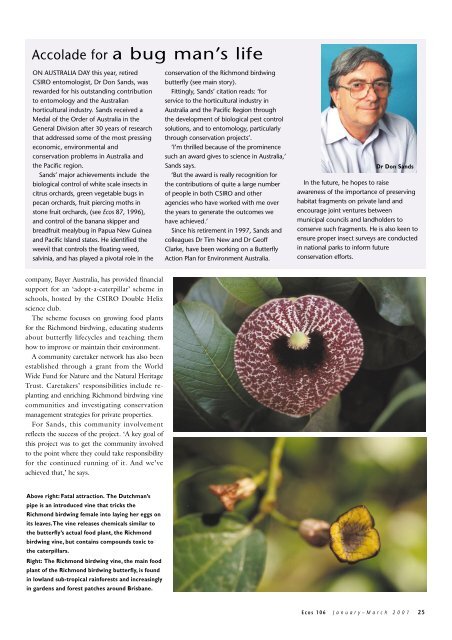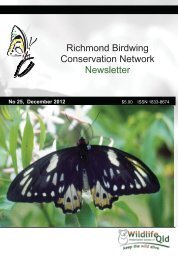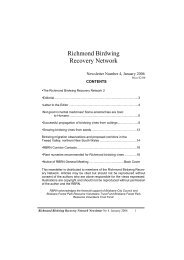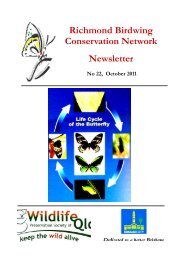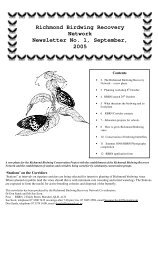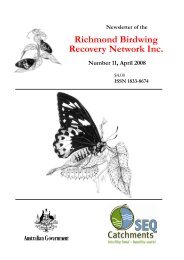Changing habitat - ECOS Magazine
Changing habitat - ECOS Magazine
Changing habitat - ECOS Magazine
Create successful ePaper yourself
Turn your PDF publications into a flip-book with our unique Google optimized e-Paper software.
Accolade for a bug man’s life<br />
ON AUSTRALIA DAY this year, retired<br />
CSIRO entomologist, Dr Don Sands, was<br />
rewarded for his outstanding contribution<br />
to entomology and the Australian<br />
horticultural industry. Sands received a<br />
Medal of the Order of Australia in the<br />
General Division after 30 years of research<br />
that addressed some of the most pressing<br />
economic, environmental and<br />
conservation problems in Australia and<br />
the Pacific region.<br />
Sands’ major achievements include the<br />
biological control of white scale insects in<br />
citrus orchards, green vegetable bugs in<br />
pecan orchards, fruit piercing moths in<br />
stone fruit orchards, (see Ecos 87, 1996),<br />
and control of the banana skipper and<br />
breadfruit mealybug in Papua New Guinea<br />
and Pacific Island states. He identified the<br />
weevil that controls the floating weed,<br />
salvinia, and has played a pivotal role in the<br />
conservation of the Richmond birdwing<br />
butterfly (see main story).<br />
Fittingly, Sands’ citation reads: ‘for<br />
service to the horticultural industry in<br />
Australia and the Pacific Region through<br />
the development of biological pest control<br />
solutions, and to entomology, particularly<br />
through conservation projects’.<br />
‘I’m thrilled because of the prominence<br />
such an award gives to science in Australia,’<br />
Sands says.<br />
‘But the award is really recognition for<br />
the contributions of quite a large number<br />
of people in both CSIRO and other<br />
agencies who have worked with me over<br />
the years to generate the outcomes we<br />
have achieved.’<br />
Since his retirement in 1997, Sands and<br />
colleagues Dr Tim New and Dr Geoff<br />
Clarke, have been working on a Butterfly<br />
Action Plan for Environment Australia.<br />
Dr Don Sands<br />
In the future, he hopes to raise<br />
awareness of the importance of preserving<br />
<strong>habitat</strong> fragments on private land and<br />
encourage joint ventures between<br />
municipal councils and landholders to<br />
conserve such fragments. He is also keen to<br />
ensure proper insect surveys are conducted<br />
in national parks to inform future<br />
conservation efforts.<br />
company, Bayer Australia, has provided financial<br />
support for an ‘adopt-a-caterpillar’ scheme in<br />
schools, hosted by the CSIRO Double Helix<br />
science club.<br />
The scheme focuses on growing food plants<br />
for the Richmond birdwing, educating students<br />
about butterfly lifecycles and teaching them<br />
how to improve or maintain their environment.<br />
A community caretaker network has also been<br />
established through a grant from the World<br />
Wide Fund for Nature and the Natural Heritage<br />
Trust. Caretakers’ responsibilities include replanting<br />
and enriching Richmond birdwing vine<br />
communities and investigating conservation<br />
management strategies for private properties.<br />
For Sands, this community involvement<br />
reflects the success of the project. ‘A key goal of<br />
this project was to get the community involved<br />
to the point where they could take responsibility<br />
for the continued running of it. And we’ve<br />
achieved that,’ he says.<br />
Above right: Fatal attraction. The Dutchman’s<br />
pipe is an introduced vine that tricks the<br />
Richmond birdwing female into laying her eggs on<br />
its leaves.The vine releases chemicals similar to<br />
the butterfly’s actual food plant, the Richmond<br />
birdwing vine, but contains compounds toxic to<br />
the caterpillars.<br />
Right: The Richmond birdwing vine, the main food<br />
plant of the Richmond birdwing butterfly, is found<br />
in lowland sub-tropical rainforests and increasingly<br />
in gardens and forest patches around Brisbane.<br />
Ecos 106 January–March 2001 25


